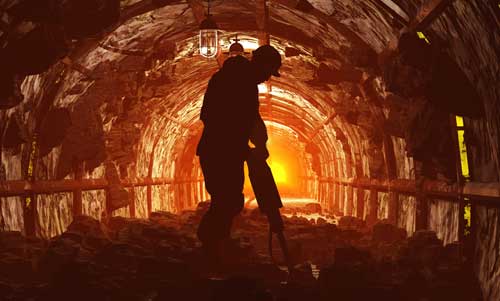 Equipment failures, cave-ins, government fines and penalties, black lung disease, changes in the regulatory environment, gas explosions, fires—these and other risks within the coal mining industry have imposed a host of costs, expenses and losses on the industry. Conventionally-available insurance has been critical in disaster recovery over the past 20 years and it has helped coal mining businesses bounce back after suffering significant losses. Conventional worker’s compensation coverages in particular, are written to mitigate health-related hazards if the unthinkable were to occur.
Equipment failures, cave-ins, government fines and penalties, black lung disease, changes in the regulatory environment, gas explosions, fires—these and other risks within the coal mining industry have imposed a host of costs, expenses and losses on the industry. Conventionally-available insurance has been critical in disaster recovery over the past 20 years and it has helped coal mining businesses bounce back after suffering significant losses. Conventional worker’s compensation coverages in particular, are written to mitigate health-related hazards if the unthinkable were to occur.
Even special divisions within the Department of Labor have been created to spearhead the processes related to claims—the Division of Coal Mine Workers' Compensation, or Federal Black Lung Program, for example, administers claims filed under the Black Lung Benefits Act. The Act provides compensation to coal miners who are totally disabled by pneumoconiosis arising out of coal mine employment, and to survivors of coal miners whose deaths are attributable to the disease (www.dol.gov). These provisions are a mainstay of the coal industry, because not unlike the oil and gas or manufacturing industries, its risks are inherent, real, and unpredictable.
The Need for Captives in High-Risk Industries

Lance McNeel
CPCU, ARM
Vice President of Business Development
Capstone Associated Services, Ltd.
----------------------------------------
A captive insurance company is a small property and casualty insurance company that is generally formed to provide insurance coverage for related businesses. Its owner may be the owner of the business or other family members or related persons. The policies written under the captive may either supplement or replace existing conventional coverages. The benefits of a business owner forming a captive are many, but in a high-risk industry where conventional coverages may carry exclusions, the choice to form a captive becomes increasingly more important. Often, unique, industry-specific coverages not readily available or too expensive in the conventional markets are written by the captive. And at the end of the day, an industry’s losses are simply charged back to that industry along with add-ons for overhead, marketing and profits of the conventional insurer.
In manufacturing, product recall is a serious business risk. A policyholder might incur a variety of ex-penses, including costs for examination, transportation, destruction, analysis, decontamination of plant sites, storage space and cancellation charges, notification to customers and end users, and advertising measures. Traditional insurance coverages may not cover these risks and specialty coverages in the commercial market may charge a high premium.
In 1982, pharmaceutical giant Johnson & Johnson faced such a dilemma when 7 people died suddenly after ingesting over-the-counter Tylenol pills laced with cyanide poison. The company ordered a nationwide recall of 264,000 bottles of Tylenol and offered free replacement of the product in safer tablet form. At the time, it was unusual for companies to recall their products. The recall and re-launch of the product cost Johnson & Johnson over $100 million. Although the company had the funds to recover, many midmarket manufacturers of pharmaceuticals, vehicles, and food products are financially liable in a product recall situation.
In oil and gas, risk coverages for pollution, bodily injury, and even cyber risks can be found commercially. But almost all umbrella coverages and some commercial general liability coverages (CGL) will have a large endorsement called “The Oil Industry Limitation Endorsement.” This is a list of exclusions that could be potentially damaging to a business owner who has not made provisions for this gap in coverage. Insureds may see verbiage on the endorsements that states that “this insurance does not cover pollution liability, loss of a hole, well, reservoir, formation, or strata, and any in-hole equipment, including fishing costs, well control costs, and more.
By forming a captive insurance company, a business owner – whether a mine owner or an equipment supplier -- has more control over his or her written policies and what claims are going to be paid in the event of a trigger. Like the coal industry, oil and gas is a specialized field, where the location, materials, etc. of your operations determines your level of risk and coverages needed. For example, potential pollution issues could arise from working on offshore oil rigs and hydraulic fracturing. Even new technology could pose new threats to a business that may be too expensive to cover via conventional insurance. Bottom line: Midmarket companies in these industries and others have an opportunity to supplement their insurance with this sophisticated and comprehensive risk management tool.
Public relations, bodily injury, regulatory changes, and other coverages are integral in the continued health of business around the globe.
Coal mining is one of the most highly regulated industries in the United States and businesses must comply with hundreds of laws, from the planning stages, to the mining work, to reclamation. It is virtually impossible to account for all risk factors associated with the industry, because when an accident occurs, the regulatory climate becomes volatile. Agencies such as OSHA and the Office of Surface Mining Reclamation and Enforcement revamp their statutes to provide both the mining companies and workers with new safety standards, a necessary and fundamentally healthy progression of the industry.
But these guidelines and the triggers for worker’s compensation coverage cannot work in a vacuum. A supplemental regulatory change policy or other broad, coverage-specific policy must work together in order to address financial losses and other risks suffered by the company. Its workers may benefit individually from worker’s comp policies, but how does a coal mining or other business with high-risk factors recover from supply chain breakdowns and changes in law that affect its ability to pay workers? What coverages can they rely on in situations where non-standard risk factors come into play, such as pollution hazards? Exclusions found in more traditional insurance coverages may carry exclusions that can lead to financial liabilities for businesses. The consequences of underinsurance could be devastating, as business owners who have done their due diligence on the front end could pay out-of-pocket to cover risks not included in their policy. With captive insurance coverage, these unforeseen perils, regulatory changes, and other risks can be addressed with broader, more inclusive coverages.
Regulatory Changes and Their Effect on Businesses
Sometimes, it is difficult to gauge any indirect consequences that regulatory changes may have on a business. Take for example the case of the latest ruling on miners’ exposure to coal mine dust and risk of Black Lung disease. Miners across the United Stated have been seriously affected by chronic exposure to air-born coal mine dust and have led to lung diseases including coal workers’ pneumoconiosis (CWP), emphysema, silicosis, and chronic bronchitis. The maladies are collectively known as “black lung” and have been responsible for thousands permanent disabilities and premature deaths among coal workers. In fact, between 1995 and 2004, more than 10,000 miners died from complications related to black lung disease.
On August 1, 2014, a new rule created by the United States Department of Labor’s Mine Safety and Health Administration went into effect, helping to safeguard against these hazards. Provisions of the rule will revise current standards by lowering the existing exposure limits, improving sampling practices, requiring the use of continuous personal dust monitors for miners in high-risk occupations and mandating immediate reaction to high dust levels, among other provisions (The State Journal). While ultimately the risks of developing black lung disease are lowered, in the short term efforts at identifying cases will increase and the costs of compliance jump. Coal mine operators will be compelled to make provisions against unintended or indirect consequences of the new rule, such as increased costs for compliance. Some businesses operating in locations where black lung disease rates are low must still comply with the law. Thousands of jobs could be lost as marginal mines are closed, coal companies would be at risk for bankruptcy, there could be a significant loss of income and mines could be forced to shut down. The measures put forth by the new rule do not account for these business risks and conventional insurance policies may not provide adequate coverage.
The importance of forming a captive insurance company is clear, as regulatory change policies can pro-tect businesses from unintended consequences of changing laws and industry standards. In addition, sudden and accidental pollution risks as well as prolonged leakage risks could be addressed by broader coverages within the captive.
Leveraging Industry Expertise in Captive Formation
Multiple Internal Revenue Code provisions, including section 831(b), provide for tax advantages for the formation and operation of a captive insurance company even where offering coverages to related businesses. Because of the complexities of these tax provisions, the formation and ongoing management of a captive must be overseen by experienced professionals who understand the insurance, tax, and legal aspects of the captive. Companies with high operating and business risks must seek the expertise of an experienced captive management team – usually headed up by a team of tax and corporate lawyers -- that has familiarity with the issues, laws, and guidelines needed to ensure its success. Just like coal mining, captive insurance formation is a dangerous road for the inexperienced.
Many “captive managers” may be able to help with clerical needs of forming a captive, but in order to assess risks properly, write the necessary policies, and support clients in the tax and legal issues associ-ated with captive management, these captive managers must have the necessary experience and training. By working with a true turnkey service provider, such as Capstone Associated, Ltd. with its affiliated The Feldman Law Firm LLP, captive owners are able to benefit from the planning and enhance their businesses’ value, all while remaining compliant. The benefits of owning a captive are far-reaching and the adoption of captive insurance is growing exponentially. In industries like coal, oil and gas, transportation, and manufacturing, this added protection could help individual workers and companies keep operating more safely and efficiently.
-------------------------------------------------------------------------------------------------------------------------------------------------------------------
Written by Lance McNeel, CPCU, ARM, Vice President of Business Development, Capstone Associated Services, Ltd.
Download a pdf copy of this article here.



